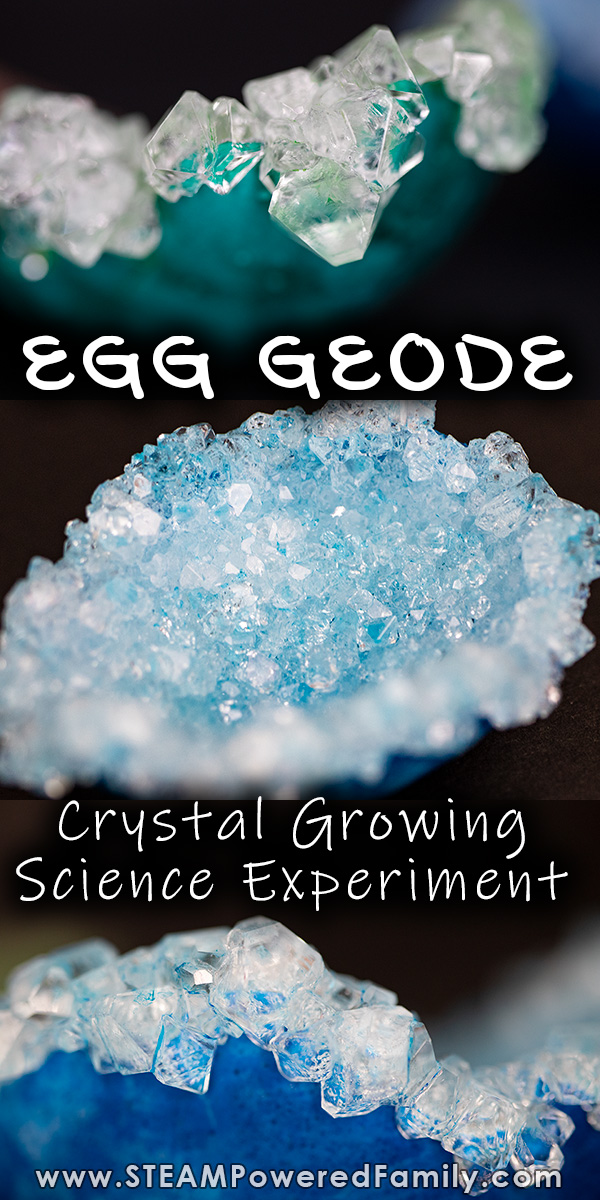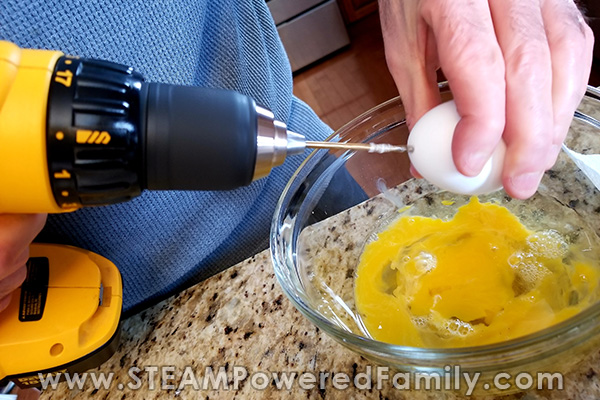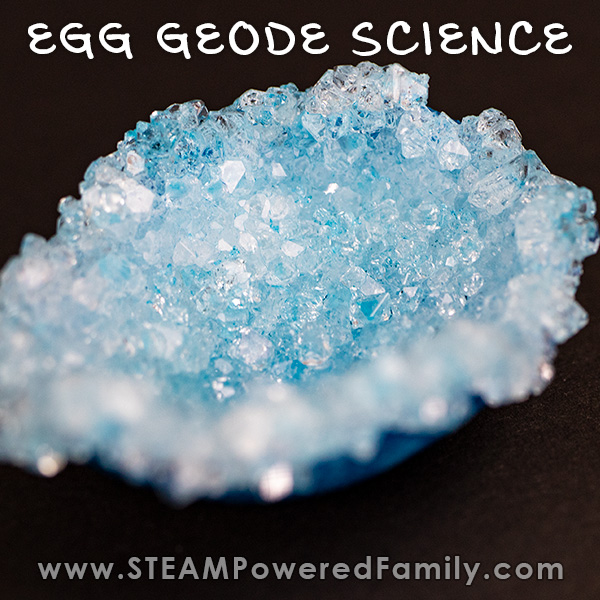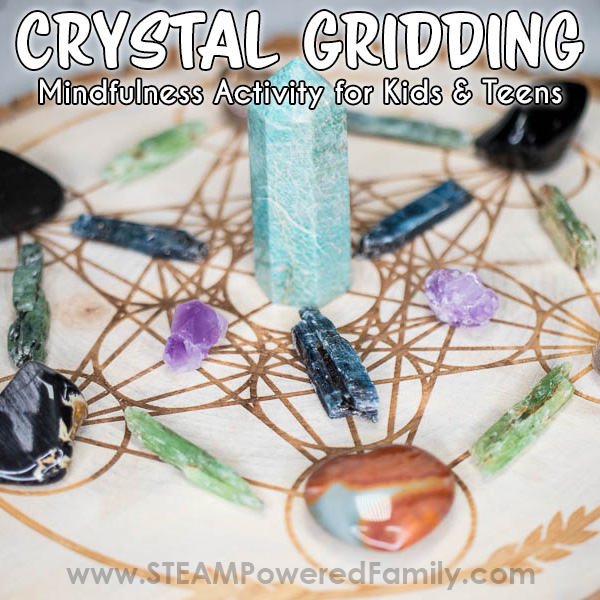Growing Crystals – Egg Geode Science Experiment
Growing crystals is always a great project for the science fair or just because we LOVE science experiments! This project has a fun twist as we make egg geodes that are filled with gorgeous crystal formations. Making it also a wonderful egg science experiment for spring time or Easter.
EGG GEODES – CRYSTAL GROWING SCIENCE

Disclaimer: This article may contain commission or affiliate links. As an Amazon Influencer I earn from qualifying purchases.
Not seeing our videos? Turn off any adblockers to ensure our video feed can be seen. Or visit our YouTube channel to see if the video has been uploaded there. We are slowly uploading our archives. Thanks!
I LOVE my crystals. My kids like to say I am obsessed. And in a way I am. I find crystals fascinating and love nothing more than holding crystals and watching the way light plays through facets. I have a large collection of rocks and crystals, and even studied geology in University. Lately I have started crystal gridding as a way of mediating and calming myself from the chaos of our every day. I find crystals captivating and they help me feel a sense of peace.

Edible Crystal Growing Experiments
In addition to the crystals formed naturally in nature, we have loved created our own crystals with science. Crystallization is a fascinating science process that provides gorgeous results that are sometimes edible! If you have followed us for some time, you know we have done a lot of candy science experiments and the main concept involved in candy making is… you got it! CRYSTALLIZATION!
Everything from lollipops to fudge to mouth watering caramels involves controlling the crystallization process.
The two that really stand out though when talking about crystallization is making rock candy and our insanely delicious Candy Geodes. Man those things tasted amazing!
Non-Edible Crystal Growing Experiments
But we have also delved into non-edible crystallization science experiments. We have made scented crystals, crystal ornaments and even studied the process for growing REALLY large crystals. Now that was a fantastic experiment that gave us amazing results!
So lots of crystal growing experiments but there was a new one I wanted to try that involved creating your own crystal geode. Finally we had the chance to try and it turned out to be quite the experiment filled with failures and investigations and fantastic learning opportunities.

Crystal Egg Geode Experiment
To do this experiment we needed some different supplies from our previous crystal growing studies. In the past we grew our crystals using borax. For this egg geode experiment we grew our crystals using Alum on the shell of an egg.
Check out this video of our Egg Geodes!
If you can’t see the video, please ensure your adblockers are turned off. They also block our video feed.
Egg Geode Supplies
Large Eggs (You want good healthy eggs with a strong shell to make this easier.)
Alum powder (They are NOT all the same! More on this in a moment.)
Mason jars or similar (you will need one per egg geode)
Water
Stove top (You could use a microwave if necessary.)
Pot
Spoons
Measuring cups and measuring spoons
Food colouring
Masking tape or painters tape
Drill (or you can use thumb tacks if necessary)
Large bowl
Scissors
White glue
Paint brush
How To Make An Egg Geode By Growing Crystals
Time needed: 1 day
How to make an Egg Geode by growing your own crystals.
- Remove the yolk and egg whites
This step is tricky! The concept is to create two holes, one on either end of the egg, then blow in one end so the insides of the egg are pushed out of the other side. The problem is that you need to ensure your hole is big enough without being too big, and that you break the membrane inside. We tried using thumb tacks and a few other tools, but found the best way to do this step was to place some masking tape or painters tape on each end, then carefully use a drill to drill a hole into each end. Then, over a large bowl, place your mouth over one end and blow into the egg to push the yolk and egg whites out the opposite end.
- Split the egg and clean it
Once you have removed the yolk and whites, take some tape and wrap a strip around the egg. Following the tape, carefully cut the shell into two halves. Once cut into two halves, remove the tape and any little bits of broken shell along the edges. Then carefully clean the shell by removing the membrane.
- Adding the seeding agent step one
To help seed our crystals we need to add some alum powder to the shells. To do this simply paint the insides of the shells (and we recommend a little on the outside edge too so your crystals “spill” over the sides), with a generous amount of standard white glue. Ensure you cover the whole area.
- Seeding the egg step two
Then sprinkle a tablespoon of alum powder over all the glue. Shaking it around to ensure you have coated the entire thing. Let sit overnight to dry completely. - Making the saturated solution
The next step is to create your super saturated solution so your crystals will form. To do this bring 2 cups of water just to boiling. Remove from heat, but before it can cool, add 3/4 cup of alum powder and stir until it dissolves.
- Colouring the solution
Divide the solution evenly into two mason jars. Add a generous amount of food colouring, about 20 drops, to each mason jar. Stir. Let the solution cool for about 30 minutes.
- Add the egg
Carefully place one egg in each jar. Use a spoon to gently push it down, so it falls to the bottom of the jar. Leave it to sit for at least 12 hours. I left some for up to 24 hours.
- Reveal your egg geode
Once it is finished, use a spoon to gently lift the egg geode from the solution. Let dry.
Failure to Success – The Importance of Alum Ingredients
Seems easy right? And really this experiment is SUPER easy. Until it isn’t and you have a massive experiment fail. We had that happen. That’s when we learned that not all alum powders are the same. Some alum powders have additives that you may not realize without careful ingredient list analysis.
We had two types of alum powder. I bought some from the bakery section of my grocery store. Then I ordered some alum powder online because it was cheaper, and frankly we were using a lot of alum powder, I wanted to save some money!
The alum powder from the grocery store worked perfectly. The online alum powder failed miserably. You will see crystals starting to form in the first few hours, so I knew something wasn’t right with the online alum powder because no crystallization was happening. I still waited the full 12 hours, but in the end my shells came out naked, with not a single crystal. So what happened?
Science Fails for Educational Wins
I actually love it when we have experiment failures. It challenges us to think critically and use our scientific investigation skills to gain a greater understanding of what is happening. These are CRITICAL skills for young scientists to develop. If every experiment was a simple and an easy success, how would we ever learn?
So we started doing some investigation. First we noted that unlike the store bought alum, the online one had bubbles forming when we added the egg. We discussed what this meant, a chemical reaction was happening. That’s not what we want. We want sedimentation and crystallization, which are not chemical reactions.
The next step was to analyze the labels of each alum powder. It didn’t take long to notice a big difference. The alum powder from the grocery store had one ingredient: Potassium Aluminum Sulfate. The one I ordered online had Ammonium added.
BINGO! We had our answer. All thanks to a little investigation and critical analysis. Or as my kids like to call it, detective work.
Tips for Crystal Growing and Egg Geodes
Removing the yolk and whites
If you are struggling to remove the yolk and whites, there are a few things you can do. If you are finding nothing comes out when you blow into one side, make sure the hole is big enough, that you are creating a seal around the one end with your mouth, and that you broke the membrane inside.. The tape helps give a little strength to the shell, but you will get a bit of breaking. The healthier and stronger the egg, the better the shell will be. If your egg shells keep breaking, try better quality eggs. Still struggling? You can always crack the eggs open the old fashion way and make your egg geodes using round geodes, rather than long oval.
Alum Not Dissolving
If your alum powder is not dissolving, reheat the solution and continue stirring until it completely dissolves.
No Crystals or Small Crystals
No crystals forming? You probably have the same issue we faced. Check your alum powder carefully, and do your own detective work. It may be that you don’t have a pure alum.
You may find your crystals are too small for your liking. Take a peek at our tips for growing really big crystals to see how you can adjust your variables to help grow those crystals larger.
Clean Up Tip
Final tip, this one is about clean up! To clean your jars, which may have crystal formations along the bottom and sides, simply rinse with really hot water. This will dissolve the crystals.
The Science of Egg Geodes and Crystal Growing
Plus more scientific investigation ideas for taking it further
The funny part with this experiment is that the egg is actually not necessary. Technically you an use any base as long as it is seeded properly. That’s because unlike an experiment like our Naked Egg Study, there is no chemical reaction. The egg is simply a surface for the crystals to form on. As a further study, why not try using other materials and see what kinds of geodes you can make?
The process we are witnessing here is sedimentation followed by crystallization. Sedimentation occurs because we are creating a super saturated solution with the alum powder. A super saturated solution is simply a solution that has more suspended particles than what would normally occur when dissolving particles into a liquid. To create a super saturated solution, we heat it. Over time the particles fall from the solution to the bottom of the jar in a process called sedimentation where they then start forming the crystal structures.
Seeding the shells, by coating them with the alum powder, gives the crystals a place to attach themselves and start growing. Why not try an experiment to compare the difference between seeded shells and unseeded shells. What happens?
This last step is my favourite. If you have some crystals around. Bring them out and compare them to your crystals. I have this large Amethyst geode piece that has gorgeous big crystals. We compared the shape and structures of the crystals, how the colours played through the crystals, and even broke out our hand held microscopes to do some up close comparisons. It was a great way to compare our man made crystals to a nature made crystal.
Happy Crystal Growing!













